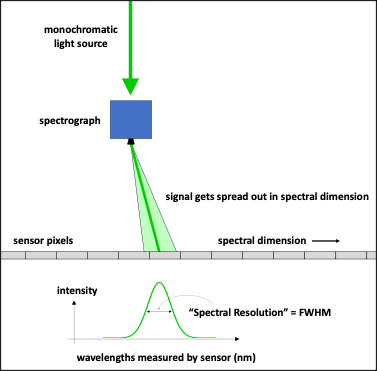Hyperspectral imaging is a powerful tool in applied spectroscopy. Hyperspectral cameras measure light from a scene in hundreds of contiguous spectral bands. A two-dimensional image is created, where each pixel contains a full spectrum. Here we discuss the most important specifications for hyperspectral imaging cameras, and how they relate to various applications.
Spectral Range
The span of wavelengths captured by the HSI camera, typically expressed in nanometers. The table below lists common spectral ranges:
| Spectral Range | Acronym | Typical Spectral Range (nm) | Common Detector Materials |
| Visible | VIS | 400 – 700 | Silicon CCD, CMOS |
| Visible + Near Infrared | VNIR | 400 – 1,000 | Silicon CCD, CMOS |
| Near Infrared | NIR | 900 – 1,700 | InGaAs |
| Short Wave Infrared | SWIR | 1,000 – 2,500 | MCT, InSb |
| Mid Wave Infrared | MWIR | 3,000 – 5,000 | InSb, PbSe |
| Long Wave Infrared | LWIR | 8,000 – 14,000 | Fourier Transform Infrared Spectroscopy (FTIR) |
Number of Spectral Channels
This is the number of spectral data points delivered by the hyperspectral camera. Spectral Channels are often called Spectral Bands; the terms “channels” and “bands” are interchangeable.
Spectral Bandwidth
The width (in nanometers) of each individual spectral channel. The spectral bandwidth is equal to the size of the Spectral Range divided by the Number of Spectral Channels.
Spectral Resolution (FWHM)
Spectral Resolution is the spectral focusing ability of a hyperspectral camera, reported in nanometers.
When a monochromatic light source enters a spectrograph, the resulting image at the sensor will not be a single wavelength, but will be spread out a little. The intensity is roughly Gaussian, and the width of the curve at half the maximum height (FWHM) is reported as spectral resolution. It is a function of both wavelength and pixel position. Common practice is to report an “average of worst-case scenarios.” In a well designed instrument, the spectral resolution is typically about the same size (or smaller) than the spectral bandwidth.

Spatial Pixels
This is the number of spatial pixels in each scan line. Each spatial pixel contains an entire spectrum of data.
Aperture
This is a measure of how much light enters the system, and is reported in “f-stops.” A larger f/# lets less light into the system, and a smaller f/# lets more light into the system. Hyperspectral imaging requires a lot of light, and small f/#’s are better.
Maximum Frame Rate
This is the speed at which lines can be scanned. It is reported in units of “frames per second” (fps). This is important for industrial machine vision applications where high speed throughput is very important, but not as important for research applications.
Bit Depth
Bit depth is the digital precision given by the sensor’s analog-to-digital signal processor. VNIR hyperspectral cameras typically provide 12-bit data, while Surface Optics’ high-precision 710-sCMOS camera produces 16-bit data. Infrared hyperspectral cameras usually provide 12- or 14-bit data. Digital values range from 0 to 2bit depth -1, which is 4,095 for a 12-bit camera and 65,535 for a 16-bit camera
Conclusion
Different hyperspectral applications have different requirements, and understanding these basic specifications is critical in choosing the best hyperspectral camera for your application. Research applications usually demand high spatial resolution and precise spectral data (i.e. small Small Spectral Resolution), along with maximum number of spectral channels. Machine vision and industrial customers will want fast hyperspectral cameras with high maximum frame rates. Budget-conscious customers will be willing to manage lower resolutions and fairly slow frame rates, while still generating scientific-grade data. Airborne remote sensing customers will be willing to sacrifice spectral resolution in favor of high optical throughput and modestly fast frame rates.
Contact us at Surface Optics to discuss your applications with our technical staff. We look forward to helping you get the hyperspectral system that best fits your needs.
